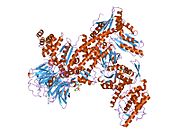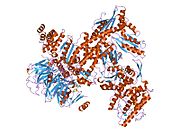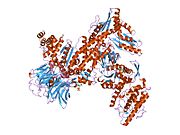ACTR3B
Appearance
(Redirected from ACTR3B (gene))
| ACTR3B | |||||||||||||||||||||||||||||||||||||||||||||||||||
|---|---|---|---|---|---|---|---|---|---|---|---|---|---|---|---|---|---|---|---|---|---|---|---|---|---|---|---|---|---|---|---|---|---|---|---|---|---|---|---|---|---|---|---|---|---|---|---|---|---|---|---|
 | |||||||||||||||||||||||||||||||||||||||||||||||||||
| Identifiers | |||||||||||||||||||||||||||||||||||||||||||||||||||
| Aliases | ACTR3B, ARP11, ARP3BETA, ARP3 actin-related protein 3 homolog B (yeast) | ||||||||||||||||||||||||||||||||||||||||||||||||||
| External IDs | MGI: 2661120; HomoloGene: 4180; GeneCards: ACTR3B; OMA:ACTR3B - orthologs | ||||||||||||||||||||||||||||||||||||||||||||||||||
| |||||||||||||||||||||||||||||||||||||||||||||||||||
| |||||||||||||||||||||||||||||||||||||||||||||||||||
| |||||||||||||||||||||||||||||||||||||||||||||||||||
| |||||||||||||||||||||||||||||||||||||||||||||||||||
| Wikidata | |||||||||||||||||||||||||||||||||||||||||||||||||||
| |||||||||||||||||||||||||||||||||||||||||||||||||||
Actin-related protein 3B also known as ARP3-beta is a protein that in humans is encoded by the ACTR3B gene.[4] Pseudogenes of this gene are located on chromosomes 2, 4, 10, 16, 22 and Y. Alternative splicing results in multiple transcript variants and protein isoforms.[4]
Function
[edit]This gene encodes a member of the actin-related proteins (ARP), which form multiprotein complexes and share 35-55% amino acid identity with conventional actin. The protein encoded by this gene may have a regulatory role in the actin cytoskeleton and induce cell-shape change and motility.[4]
References
[edit]- ^ a b c GRCm38: Ensembl release 89: ENSMUSG00000056367 – Ensembl, May 2017
- ^ "Human PubMed Reference:". National Center for Biotechnology Information, U.S. National Library of Medicine.
- ^ "Mouse PubMed Reference:". National Center for Biotechnology Information, U.S. National Library of Medicine.
- ^ a b c "Entrez Gene: ACTR3B ARP3 actin-related protein 3 homolog B (yeast)".
External links
[edit]- Human ACTR3B genome location and ACTR3B gene details page in the UCSC Genome Browser.
Further reading
[edit]- Machesky LM, Gould KL (Feb 1999). "The Arp2/3 complex: a multifunctional actin organizer". Current Opinion in Cell Biology. 11 (1): 117–21. doi:10.1016/S0955-0674(99)80014-3. PMID 10047519.
- Ewing RM, Chu P, Elisma F, Li H, Taylor P, Climie S, McBroom-Cerajewski L, Robinson MD, O'Connor L, Li M, Taylor R, Dharsee M, Ho Y, Heilbut A, Moore L, Zhang S, Ornatsky O, Bukhman YV, Ethier M, Sheng Y, Vasilescu J, Abu-Farha M, Lambert JP, Duewel HS, Stewart II, Kuehl B, Hogue K, Colwill K, Gladwish K, Muskat B, Kinach R, Adams SL, Moran MF, Morin GB, Topaloglou T, Figeys D (2007). "Large-scale mapping of human protein-protein interactions by mass spectrometry". Molecular Systems Biology. 3 (1): 89. doi:10.1038/msb4100134. PMC 1847948. PMID 17353931.
- Shindo-Okada N, Iigo M (Dec 2003). "Expression of the Arp11 gene suppresses the tumorigenicity of PC-14 human lung adenocarcinoma cells". Biochemical and Biophysical Research Communications. 312 (4): 889–96. doi:10.1016/j.bbrc.2003.10.200. PMID 14651955.
- Shindo-Okada N, Shimizu K (Jan 2001). "Isolation of a novel actin-related gene expressed in low-metastatic PC-14 human lung adenocarcinoma". Biochemical and Biophysical Research Communications. 280 (1): 61–7. doi:10.1006/bbrc.2000.4059. PMID 11162478.
- Jay P, Bergé-Lefranc JL, Massacrier A, Roessler E, Wallis D, Muenke M, Gastaldi M, Taviaux S, Cau P, Berta P (May 2000). "ARP3beta, the gene encoding a new human actin-related protein, is alternatively spliced and predominantly expressed in brain neuronal cells". European Journal of Biochemistry. 267 (10): 2921–8. doi:10.1046/j.1432-1327.2000.01306.x. PMID 10806390.
This article incorporates text from the United States National Library of Medicine, which is in the public domain.













